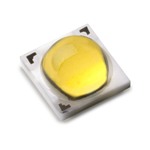The new Luxeon T is intended by Lumileds to be the primary LED sold into high-power, directional SSL products such as downlights and MR16 and PAR retrofit lamps.
Philips Lumileds has introduced the new Luxeon T series of high-power LEDs that target solid-state lighting (SSL) applications with directional-beam requirements including downlights, and MR16 and PAR retrofit lamps. The LEDs set new efficacy milestones for Lumileds achieving 140 lm/W at 350 mA of drive current. CEO Pierre Yves Lesaicherre touted the benefits of the new family, discussed Lumileds LED manufacturing technology, and commented on the development of the lime-green LED that was critical to the recent launch of the color-tunable Hue lamp by Philips lighting.

Philips Lumileds Luxeon T
Lesaicherre emphasized that Lumileds considers the Luxeon T much more than an evolution of the Lumileds family saying, "The Luxeon T is going to be the workhorse in terms of high efficacy." Clearly Lumileds expects Luxeon T to be the product of choice for applications in which the LED is expected to produce maximum forward light.
Lumileds claims several breakthroughs for the new series beyond efficacy, including what it says is an industry-lowest 2.7V forward voltage and 3°C/W thermal resistance. Product line director Kathleen Hartnett said that only one other LED maker has reached 2.8V and that most are at 3V or above. The lower forward voltage simplifies the thermal design – especially critical in space-constrained directional lamps such as MR16 retrofits.
Lumileds will offer the LEDs in 3-step MacAdam ellipse bins, tested at 85°C. Lesaicherre said that the company is not matching phosphor tiles with emitters the way it did in the original Rebel Lumiramic-based LEDs to reach the tight binning, but instead controlling the epitaxial (epi) process more tightly.
Epitaxial improvements
Indeed, better process control is behind both the binning and the lower forward voltage. Lesaicherre said, "The conversion to 6-in substrates has really helped because we have more modern equipment." Specifically, he said they have tighter control of temperature and gas distribution in the epi process.
"We change our epi recipe every six months on average," said Lesaicherre. The Luxeon T is made with the latest recipe. Moreover, the company developed chip-architectural and packaging enhancements to maximize light output and efficacy.
The new family utilizes a chip-in-frame package with a tightly coupled optical dome. The combination of a small 2-mm2 emitting surface and properly sized dome is critical in directional applications. For more detail on that topic, see our recent article, "Design considerations for enhancing LED efficiency."
The LED package measures 3.7×3.7 mm. The prior Luxeon A product targeted similar applications but features a rectangular pattern. Hartnett said the package design minimizes the footprint and allows the LEDs to be packed more closely together. The company has used the same package in the multi-emitter Luxeon M family.
The new LEDs offer a minimum CRI of 80, and optionally a CRI of 95, across the full range of CCTs, including 2700K, 3000K, 3500K, 4000K, and 5000K. With the high minimum, the LEDs will primarily find use in indoor lighting. Expect a complementary product with a lower CRI for outdoor applications down the road.
The Luxeon T design in aggregate is a good match for the target directional applications. "Luxeon T is able to deliver high center beam candle power and precise optical control, which are required to deliver the narrow beams desired for these systems."
Hue's lime-green LED
We used the chanced to interview the Lumileds executives to ask other questions as well such as for details on the mysterious lime-green LED that is presumably very important to the function of the Philips Lighting Hue lamp. Lesaicherre was guarded with details but said that Lumileds had advanced the efficacy of green LEDs that in general has trailed other colored LEDs industry wide.
Reportedly the lamp uses five of the lime-green LEDs, four red LEDs, and 2 blue LEDs. That means that the green LED is approaching the efficacy of the red ones.
The lime-green color itself was not the source of the efficacy gain. Instead, that lime-green LED better enables the mixture to deliver the full color-tunable range according to Hartnett. Lumileds does plan to offer a lime-green LED commercially, but is still mulling over plans as to which Luxeon family in which it will launch the product.
Low to high power
Given the emphasis Lumileds is placing on Luxeon T, we also asked Lesaicherre about the expectations going forward of whether SSL developers will focus on high-power LEDs or use the low- and mid-power devices that were originally developed for the backlighting industry. Read "LED makers broaden product lines to match application requirements" for background on the segments.
Lesaicherre said, "The high-power segment is emerging faster than anyone had expected." But market researchers at our sister organization Strategies Unlimited have reported a surge of activity in the low- and mid-power segment.
The greater lumen output in the newest mid-power devices is exciting according to Lesaicherre. He added, "In mid power, the lumen per dollar is hard to ignore."
Still, Lesaicherre expects application requirements to drive the choice. He said mid-power LEDs will do well in omnidirectional products such as standard A-lamps, and that the low-power LEDs are a good match for linear lighting. He expects directional indoor and outdoor applications to continue to be almost exclusively based on high-power LEDs – both single emitter LEDs and chip-on-board (COB) arrays.





